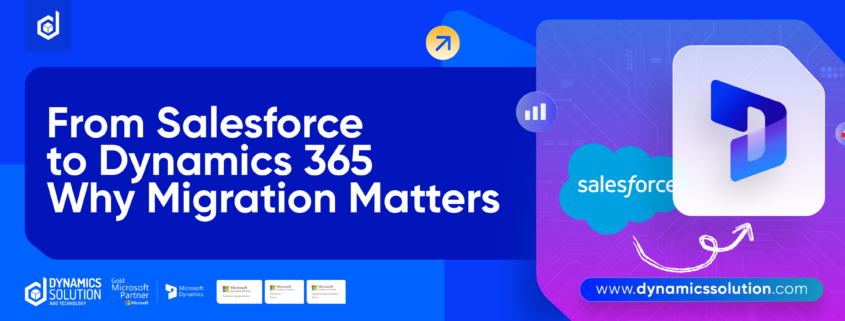Change is hard but stagnating in the current situation is riskier. Many companies find their original CRM no longer fits evolving needs. In fact, industry research shows that roughly two-thirds of organizations are now likely to consider switching CRM. Common triggers include an outgrown system that can’t deliver new features or integrate with modern tools. In other cases, the current CRM’s cost structure or complexity drives a change.
When evaluating the best CRM solution, businesses often weigh leading options like Salesforce Sales Cloud against Microsoft’s offering. One factor tipping the scales is how well a CRM fits your ecosystem and goals.
Below, we explore why organizations switch CRMs and why Dynamics 365 Sales is often chosen, then outline how to migrate Salesforce to Dynamics 365 safely and successfully.
Why Businesses Consider Switching CRMs?
Businesses switch CRMs when their old system no longer delivers value. Common reasons include outdated features and performance. Furthermore, cost is another driver for this switch. Organizations facing high Total Cost of Ownership (TCO) from complex Salesforce pricing and add-ons often seek a more predictable model. Finally, growth or strategy changes (new sales processes, products or business units) can render the current CRM unsuitable. In short, if you’re “not getting value” from your existing system, it might be time to move on.
Let’s understand the reasoning behind it in detail.
| Criteria | Salesforce Sales Cloud | Dynamics 365 Sales |
| Deployment | Cloud-only | Cloud & On-premises options |
| Integration | Limited with Microsoft tools | Native integration with Office 365, Teams, Outlook |
| Customization | High, but complex (uses Apex) | Flexible, easier with familiar tech stack (.NET, C#) |
| AI Capabilities | Einstein (add-on, premium) | Copilot included (AI insights, automation) |
| Pricing | Higher TCO with tiered add-ons | More cost-effective, modular pricing |
| User Experience | Custom UI, requires training | Familiar Office-like UI, easier adoption |
| Reporting & Analytics | Advanced with add-ons | Built-in with Power BI integration |
| Best For | Standalone CRM users | Microsoft ecosystem users seeking unified operations |
Evolving Needs and Functionality: Technology moves fast. A decade-old CRM may not support new sales channels, AI insights or integrated analytics. Many firms outgrow their original CRM and look for a modern platform that keeps up the pace.
Integration with Other Tools: Companies entrenched in the Microsoft stack often prefer tighter integration. For them, a CRM that syncs seamlessly with Office 365, Outlook, Teams and Azure is very appealing. This reduces switching between apps and improves productivity.
Cost and Licensing: Over time, rising subscription fees or costly add-ons can prompt migration. Microsoft’s Dynamics 365 often presents a lower total cost with broader features in each plan. For example, Dynamics 365 licensing runs roughly 35% cheaper for comparable functionality.
By identifying these drivers, companies can justify the effort of migration. The goal is a CRM aligned to business needs, potentially the best CRM for them rather than one being maintained out of inertia.
Strategic Advantages of Dynamics 365 Sale
Microsoft’s Dynamics 365 Sales brings unique strengths that appeal to many Salesforce users. In a side-by-side comparison, you’ll notice several strategic advantages such as:
Native Microsoft Integration
Dynamics 365 ties directly into other products. Sales reps can create quotes from Outlook or update customer records during a Teams call without switching platforms. This seamless ecosystem boosts efficiency and user adoption.
Competitive Pricing and Bundling
Dynamics 365 often delivers a more cost-effective solution. It can be less expensive than Salesforce for similar feature sets. Moreover, features like basic sales intelligence and analytics are typically included whereas Salesforce may charge extra for Einstein AI or advanced reporting. In fact, Microsoft notes that Dynamics 365 gives companies more for less, driving greater business value.
Flexible Customization and Modules
Dynamics 365 Sales is part of a broader business suite (CRM + ERP). It’s modular and works as a PaaS (Platform as a Service), so you can easily add capabilities (Field Service, Marketing, Finance, etc.) without overhauling the system. The platform uses common development tools (HTML, C#, .NET), giving access to a larger developer pool. By contrast, Salesforce customization often requires proprietary Apex code and paid API calls. Dynamics 365 includes API access and customizability at lower extra cost.
Built-in AI and Analytics
Microsoft has embedded AI across Dynamics 365. For instance, Copilot for Sales is an AI assistant that automatically summarizes records, surfaces insights and even drafts emails. Sellers can ask Copilot questions in natural language or use prompts (e.g. “summarize my opportunities”) to gain insights on the fly. Power BI integration also provides rich dashboards and predictive analytics without leaving the CRM. These capabilities come standard while Salesforce requires Einstein or other add-ons to match them.
User-Friendly Interface
Many users find Dynamics 365’s UI familiar if they already use Microsoft products. Its look-and-feel aligns with Office apps, easing training. In contrast, long-time Salesforce users may resist change but new users often like D365’s simplicity.
Effective Security and Compliance
Dynamics 365’s security features meet global standards, with advanced role-based controls and encryption. Microsoft emphasizes that customers retain full control of their data and backups are included in subscriptions, addressing concerns like API access fees or backup costs sometimes imposed by other vendors.
Together, these factors make Dynamics 365 Sales a compelling choice. In effect, Salesforce vs Dynamics 365 becomes a question of ecosystem and economics where Dynamics 365 shines in Microsoft-centric environments and on total-cost metrics while Salesforce shines in a purely SaaS plug-and-play model. So we can say that choosing the best CRM depends on your context. However, Dynamics 365 is often considered top-tier for companies wanting deep Microsoft integration and an all-in-one platform.
Key Steps and Best Practices in Migration
Migrating from Salesforce to Dynamics 365 is a major project. It requires clear planning and disciplined execution. Below are key steps and best practices to guide the process:
1. Define Goals and Requirements
Before touching data, gather stakeholders and outline why you’re switching. List the pain points in Salesforce and the capabilities you need in Dynamics 365. What sales/marketing processes should improve? Which issues will Dynamics 365 solve? Creating a shared migration vision early helps focus the project on business value.
2. Craft a Detailed Migration Plan
Treat the migration as a strategic initiative and not just an IT task. Document all Salesforce customizations, fields and workflows. Work with an experienced Microsoft partner or consultant like Dynamics Solution and Technology to map out each phase. This plan should align with business processes, timeline and budget. Make sure to involve both technical staff and end users so that all requirements are met.
3. Cleanse and Audit Your Data
A best practice is to profile and clean your Salesforce data before migration. Review data quality; remove duplicates, archive obsolete records and standardize formats. Poor data quality can lead to financial losses, so validate accuracy now. Create a data-mapping document that will list each Salesforce field and where it should land in Dynamics 365. Note any custom fields (Misfits) that don’t have direct equivalents. Addressing these issues early avoids headaches later.
4. Configure Dynamics 365 and Migrate in Phase
Set up a clean Dynamics 365 Sales environment reflecting your mapped structure. Begin by loading a subset of data as a test. Many teams use built-in tools (like the Microsoft Data Migration Assistant) or third-party ETL tools to automate transfer. Thoroughly test the migration with sample data to ensure fields align. Fix any mapping errors or missing data issues before full migration. Once satisfied, perform the full data transfer. Monitor the process closely so any errors can be addressed in real time.
5. Rebuild Customizations and Integrations
As you migrate, you’ll need to recreate any essential Salesforce customizations in Dynamics 365. This might involve building new business processes or adjusting workflows to fit the D365 model. Also review all third-party integrations (e.g. ERP, marketing, support systems). Some Salesforce integrations won’t work in Dynamics 365, so plan how to re-establish data flows. Remember, Dynamics 365 supports hundreds of out-of-the-box connectors and has an open API which can simplify integration with common tools.
6. Prepare Users with Training and Support
A migration’s success depends on user adoption. Develop a comprehensive training plan including workshops, documentation and support, so your team can use Dynamics 365 confidently. Appoint a project champion (an internal leader) to own the process, communicate benefits and collect feedback. This person keeps the project on track, addresses concerns early and prevents the migration from derailing.
By following these steps, especially planning, data cleansing, testing and user engagement, you’ll align the technical process with your strategic goals. With careful execution, you can migrate Salesforce to Dynamics 365 with minimal disruption and maximum future value.
Data Migration Planning and Execution
A well-executed migration sets the stage for long-term success. It involves extracting tens of thousands of records (accounts, contacts, leads, opportunities, etc.) from Salesforce and loading them into Dynamics 365. To plan this safely you must:
- Profile Your Data
- Set Data Standards
- Map and Transform
- Migrate in Batches and Test
- Execute the Full Migration
As noted earlier, ensuring clean, current and relevant data is one of the most important elements of a switch. Investing time in this phase ensures your Dynamics 365 instance starts with a solid foundation.
Business Value After Migration
After the hard work is done, the business impact of a successful Salesforce to Dynamics 365 migration can be substantial. A unified Microsoft-based CRM drives productivity, insights, and ROI in several ways as listed below:
- Improved Sales Productivity
- Stronger Data Insights
- Lower Operational Costs
- Scalability for Growth
- Enhanced Security and Compliance
Start Your CRM Transformation with Dynamics Solution and Technology
Explore Dynamics 365 Sales features and consider a trial or consulting session. With the right approach, you’ll not only “migrate” data, but migrate your business to a more integrated, efficient future.
Partner with Dynamics Solution and Technology, a leading Microsoft Gold Partner. We specialize in Salesforce to Dynamics 365 migration, delivering tailored CRM implementations backed by years of experience, certified consultants and proven methodologies. From data migration to system customization and user training, we handle it all. Contact us to integrate to a CRM that meets long-term success.






